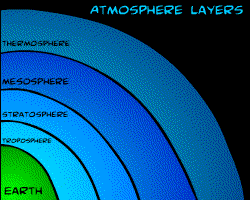 Heritage Community Foundation Presents
Heritage Community Foundation PresentsAlberta Online Encyclopedia
 |
 |
||
|
|
Air QualityAir quality is a measure of the cleanliness of the air we breathe. Nearly everything we do and every product we buy creates some form of pollution. Some of this pollution gets into the air in the form of gases or particles. One of the main problems with air pollution is deciding when it occurs. For example, when is the exhaust from cars and trucks causing too much pollution? In Alberta, governments, industries, and citizens work together to set standards which limit the amount and types of pollution allowed into the air. Standards allow us to control emissions. By measuring the amount of certain pollutants in the air, we can obtain a measure of air quality. Life on Earth exists within a narrow band called the biosphere. The biosphere is only about 15 kilometres in depth. There are three parts to the biosphere; the lithosphere (rock and soil), the hydrosphere (water) and the atmosphere (air). The atmosphere extends outwards from the earth's surface for several hundred kilometres and is made up of four layers.
Air pollution from natural sources has been a feature of the earth for millions of years. Many scientists believe the extinction of the dinosaurs was caused by a large asteroid which hit the earth. The cloud of dust caused by the collision was so thick that the earth cooled and the dinosaurs could not survive in the changed environment. Volcanic smoke and dust, sand and dust storms, and wild fires are all sources of "natural" air pollution. In fact, air borne particulates from volcanic eruptions have shown strong correlation with climate variability. Early humans have also contributed to air pollution by setting
fires to drive Today, many visible effects of air pollution have been
eliminated in North America. Cleaner fuels such as natural gas are
being used and manufacturing processes reduce their emissions by being more efficient
in their use of energy and raw materials. Many smokestacks have
dust collectors or scrubbers to reduce harmful emissions. Not all
pollutants can be removed completely, but the smokestack giving off
thick black smoke is nearly a thing of the past, at least in North
America.
Reprinted from Focus On Air Quality (1993) with permission of Alberta Environment. |
||
For more on the natural history of Alberta, visit Peel’s Prairie Provinces.









 game or to clear land. Poorly designed fireplaces
in dwellings with inadequate ventilation created smoky indoor
environments. The early industrial cities of Europe and North America
were probably the most polluted environments created by man. Most
power and household heating came from coal fires. The thick black
smoke from these fires hung over the cities and blackened exposed
surfaces with soot. Other pollutants like sulphur dioxide and
oxides of nitrogen were also present. By the 1950s people were
beginning to realize that pollution was affecting their health and the
health of plants and animals.
game or to clear land. Poorly designed fireplaces
in dwellings with inadequate ventilation created smoky indoor
environments. The early industrial cities of Europe and North America
were probably the most polluted environments created by man. Most
power and household heating came from coal fires. The thick black
smoke from these fires hung over the cities and blackened exposed
surfaces with soot. Other pollutants like sulphur dioxide and
oxides of nitrogen were also present. By the 1950s people were
beginning to realize that pollution was affecting their health and the
health of plants and animals.